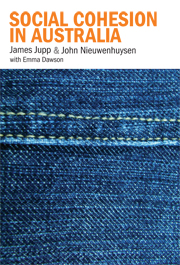Book contents
- Frontmatter
- Contents
- Foreword
- List of contributors
- List of tables
- Acknowledgments
- Introduction
- PART I DEFINING, MEASURING AND SEEKING SOCIAL COHESION
- PART II THE DYNAMICS OF SOCIAL COHESION
- 5 The landmark of Cronulla
- 6 Policing the other: Lebanese young people in a climate of conflict
- 7 Religious resurgence and diversity and social cohesion in Australia
- 8 Family and nation: the Indigenous/non-Indigenous relationship
- 9 Social cohesion and cultural fragility: a paradox of Indigenous rapports with Eurasian Australia
- 10 Educational attainments, inter-ethnic marriage and social cohesion
- PART III INFLUENCES AND RESPONSES IN SEARCHING FOR SOCIAL COHESION
- References
- Index
5 - The landmark of Cronulla
Published online by Cambridge University Press: 22 September 2009
- Frontmatter
- Contents
- Foreword
- List of contributors
- List of tables
- Acknowledgments
- Introduction
- PART I DEFINING, MEASURING AND SEEKING SOCIAL COHESION
- PART II THE DYNAMICS OF SOCIAL COHESION
- 5 The landmark of Cronulla
- 6 Policing the other: Lebanese young people in a climate of conflict
- 7 Religious resurgence and diversity and social cohesion in Australia
- 8 Family and nation: the Indigenous/non-Indigenous relationship
- 9 Social cohesion and cultural fragility: a paradox of Indigenous rapports with Eurasian Australia
- 10 Educational attainments, inter-ethnic marriage and social cohesion
- PART III INFLUENCES AND RESPONSES IN SEARCHING FOR SOCIAL COHESION
- References
- Index
Summary
In Sydney on Sunday, 11 December 2005, riots on Sydney's Cronulla beach sent a tremor through Australian community relations. Images of thousands of mainly drunk white males chasing and bashing isolated men and women of ‘Middle Eastern appearance’ were compelling viewing for media audiences in Australia, and overseas (Poynting 2006). Days later, a retaliatory gang of males of ‘Middle Eastern appearance’ sought revenge in a smash, bash and flee raid in their cars on the suburbs surrounding Cronulla. For months afterwards, an unprecedentedly large police presence dominated the sandscape of Sydney's famous beaches, successfully preventing further reverberations and escalation of racial conflict. The ramifications and significance of these events should not be underestimated.
Sydney is one of the greatest immigrant cities in the world today. At the 2001 Census 58 per cent of Sydneysiders were first- or second-generation immigrants, with some 180 birthplaces recorded for the city's resident population. Australia overall has, in relative terms, more immigrants from a greater diversity of backgrounds than most countries in the world today, making it one of the most cosmopolitan of contemporary Western nations.
To some international commentators (Huntington 1997, 2004), the clash of ethnicities and religions, mostly a product of immigration policies, threatens Western societies in fundamental ways, particularly after 9/11. Recent events overseas and in Australia associate immigration and ethnic diversity with conflict and violence.
- Type
- Chapter
- Information
- Social Cohesion in Australia , pp. 61 - 69Publisher: Cambridge University PressPrint publication year: 2007
- 13
- Cited by



